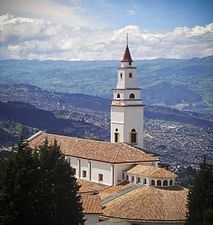Provinces Eastern Province First ascent Pre-Columbian era | Region Cundinamarca Elevation 3,152 m | |
 | ||
Easiest route FunicularTeleférico de MonserratePilgrimage trail Similar El Peñón de Guatapé, Nevado del Ruiz, Montserrat, El Totumo, Nevado del Tolima | ||
Monserrate (after Catalan homonym mountain Montserrat) is a mountain that dominates the city center of Bogotá, the capital city of Colombia. It rises to 3,152 metres (10,341 ft) above the sea level, where there is a church (built in the 17th century) with a shrine, devoted to El Señor Caído ("The Fallen Lord").
Contents
- Map of Monserrate BogotC3A1 Bogota Colombia
- Monserrate bogota colombia english
- Pre Columbian era
- Colonial period
- Tourism
- Funicular
- Telefrico de Monserrate cable car
- References
Map of Monserrate, Bogot%C3%A1, Bogota, Colombia
The hill, already considered sacred in pre-Columbian times when the area was inhabited by the indigenous Muisca, is a pilgrim destination, as well as a major tourist attraction. In addition to the church, the summit contains restaurants, cafeteria, souvenir shops and many smaller tourist facilities. Monserrate can be accessed by aerial tramway, a funicular or by climbing, the preferred way of pilgrims. The climbing route, however, has been indefinitely closed due to drought, and the associated wildfires and landslides.
All downtown Bogotá, south Bogotá and some sections of the north of the city are visible facing west, making it a popular destination to watch the sunset over the city. Every year, Monserrate and its neighbour Guadalupe attract many tourists.
Monserrate bogota colombia english
Pre-Columbian era
The history of Monserrate goes back to the pre-Columbian era. Before the Spanish conquest, the Bogotá savanna]] was inhabited by the Muisca, who were organised in their loose Muisca Confederation. The indigenous people, who had a thorough understanding of astronomy, called Monserrate quijicha caca; "grandmother's foot". At the solstice of June, the Sun, represented in their religion by the solar god Sué, rises exactly from behind Monserrate, as seen from Bolívar Square. The Spanish conquistadors in the early colonial period replaced the Muisca temples by catholic buildings. The first primitive cathedral of Bogotá was constructed on the northeastern corner of Bolívar Square in 1539, a year after the foundation of the capital of the New Kingdom of Granada.
Colonial period
In the 1620s, the Cofradia de la Vera Cruz ("Brotherhood of Vera Cruz") began using the Monserrate's hill top for religious celebrations. As time passed, many devoted residents of Bogotá began participating in the climb to the hill top. In 1650, four gentlemen met with the Archbishop as well as Juan de Borja, the head of the Tribunal of Santafe de Bogotá, in order to secure permission to build a small religious retreat on the top of Monserrate. The founders decided to establish the hermitage retreat in the name of Monserrat's Morena Virgin. Her sanctuary was located in Catalonia, near Barcelona, giving the mountain the name Monserrate. Some people believe Montserrat was chosen to be the patron saint, due to one of the founders, Pedro Solis, having an uncle who had previously served as abbot in the Montserrat sanctuary.
By 1656, Father Rojas had been assigned guarding the sanctuary and ordered the carving of a crucifix and a statue of Jesus Christ. After this statue was taken off the cross, it earned the name El Señor Caído ("The Fallen Lord"). Originally, these sculptures were placed inside a small chapel dedicated to the adoration of Christ instead of being placed inside the religious retreat itself. As time passed, more and more people began visiting the sanctuary in order to see the statue of Jesus, rather than the matron saint of Monserrat. By the 19th century, the statue of "The Fallen Lord" had gained so much attention, that the sculpture to the Virgin of Montserrat was removed from the hill as the center piece of the sanctuary and replaced with "El Señor Caido". The mountain has retained the name Monserrate afterwards. Ever since then, for more than four centuries, pilgrims and citizens have hiked the mountain to offer their prayers to the shrine of "El Señor Caido".
Tourism
Both Monserrate and its neighbor Guadalupe Hill are icons of Bogota's cityscape. The hill is a touristic attraction with a funicular, cable car, or pilgrimage climbing trail access.
